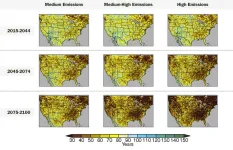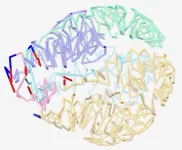Scientists at Scripps Institution of Oceanography at UC San Diego and the Department of Energy’s Lawrence Berkeley National Laboratory (Berkeley Lab) report that extremely intense days of rain or snow will be more frequent by the end of this century than previously thought – as often as once every 30 or 40 years in the Pacific Northwest and southeastern United States.
The conclusions come from analyzing a 30-terabyte data set that models temperature and precipitation at scales roughly the size of urban ZIP codes: six kilometers (3.9 miles). Researchers developed the data set, called Localized Constructed Analogs Version 2 (LOCA2), to provide climate information that is useful for local planners. In contrast, most of the existing advanced climate models look at regions that range from 50 to 250 kilometers (30 to 400 miles).
“With this data set, we’re able to look at the impacts of actual weather pattern changes across the United States at an extremely granular level,” said Dan Feldman, staff scientist at Berkeley Lab and the project’s principal investigator. “We see that there is a lot more extreme weather that is likely to happen in the future – and by looking at actual weather patterns, we show that changes in extreme precipitation will actually be more extreme than previously estimated. Land use managers and planners should expect more extremes, but location matters.”
The LOCA2 data set updates a similar analysis conducted in 2016 in advance of the Fourth National Climate Assessment (NCA), which was released in 2018 by the U.S. Global Change Research Program. The NCA is intended to assist the U.S. government with planning for, mitigating, and adapting to changes in climate that will affect the country. The Fifth NCA is expected to be issued later this year.
LOCA2 projections cover the lower 48 states of the United States, southern Canada, and northern Mexico. The data set draws on more than 70 years of weather data and incorporates 27 updated climate models from the Coupled Model Intercomparison Project (CMIP6), the latest iteration of an international effort to simulate climate that includes the “coupling” of natural systems such as the ocean and atmosphere to understand how they will act in concert as climate changes.
“We've spent a lot of effort improving the representation of extreme wet days, which is important for understanding both the likelihood of flooding and the availability of water for agricultural, commercial, and residential use,” said David Pierce, a scientist at Scripps Oceanography and the developer of LOCA and LOCA2.
The LOCA2 climate projections are available through the end of the century down to the daily level, and for three different greenhouse gas emissions scenarios known as SSPs, or Shared Socioeconomic Pathways. The three scenarios are a medium level of emissions that is slightly less than current levels (SSP 245), medium-high (SSP 370), and high, where emissions greatly increase (SSP 585). The data set is freely available for planners and decision makers to use.
The projection reinforces what climate scientists have long predicted: Future weather events will become more extreme in a warming world. LOCA2 finds that the heaviest days of rain and snowfall across much of North America will likely release 20 to 30 percent more moisture than they do now. Much of the increased precipitation will occur in winter, potentially exacerbating flooding in regions such as the upper Midwest and the west coast.
“The big picture is clear: it’s getting warmer and wetter,” Feldman said. “This research translates that bigger picture into more practical data for infrastructure and operations planning. With this more detailed look at local impacts, we can help local officials make better-informed decisions, such as how long to make an airport runway, how much resilience to include for constructing buildings or bridges, or where to put crops or culverts.”
The improved set of LOCA2 data was created by better identifying and preserving extreme weather events in the past, training models to more accurately reflect extremes in simulations of the future.
“We undertook a Herculean effort of personnel and computer time not just to produce a bunch of numbers, but to produce local projections that are relevant and useful,” Feldman said. “We do so by recognizing how heat waves and storms have occurred and will occur at the local level, and projecting those forward.”
Seasonal and regional predictions
While the data varies at the local level, researchers found substantial trends across the area covered by LOCA2 at the end of the century.
Across most seasons, a major part of North America will see roughly the same or fewer number of days with precipitation, roughly the same or fewer number of days with light and medium amounts of precipitation, and a large increase in the number of days with the most extreme precipitation (the top 1 percent and 0.1 percent of storms).
“People will be more affected by the really rare and most extreme events, because those are showing the biggest increase,” said Pierce, who is the lead author of the paper on extreme precipitation published in the Journal of Hydrometeorology. “The wettest day you would expect to see in five years, or 50 years, or 500 years – those extreme events are going to be substantially wetter, and that’s a really big issue, because it has implications for flooding and run-off.”
Southern Canada and most of the United States will see increases in extreme precipitation days that occur primarily in winter. The wettest days of precipitation will increase by 20-30 percent, depending on the emissions scenario and how extreme the storm is.
Arizona, New Mexico, and northern Mexico can expect increases in extreme precipitation days that occur primarily in autumn. The wettest days of precipitation increase by 10-30 percent, depending on which emissions scenarios come to be and how extreme the storms are. While the region becomes drier overall, the number of days with extreme precipitation events still goes up, meaning the precipitation that does come will often do so in larger storms.
“It’s quite interesting that you see the same kind of pattern of fewer low- and medium- precipitation days and more extreme precipitation days across pretty much the entire country,” Pierce said. Knowing the changing character of precipitation and the frequency of extreme events is useful in two ways, Pierce added. “One is for building new infrastructure in the future, and one is for understanding impacts upon existing facilities already there.”
Funding for this research was provided by the Department of Defense and Department of Energy through the Strategic Environmental Research and Development Program (SERDP). The NASA High-End Computing Capability (HECC) Program provided resources supporting this work through the NASA Earth Exchange (NEX), Earth Science Division, and the NASA Advanced Supercomputing (NAS) Division at Ames Research Center.
###
Founded in 1931 on the belief that the biggest scientific challenges are best addressed by teams, Lawrence Berkeley National Laboratory and its scientists have been recognized with 16 Nobel Prizes. Today, Berkeley Lab researchers develop sustainable energy and environmental solutions, create useful new materials, advance the frontiers of computing, and probe the mysteries of life, matter, and the universe. Scientists from around the world rely on the Lab’s facilities for their own discovery science. Berkeley Lab is a multiprogram national laboratory, managed by the University of California for the U.S. Department of Energy’s Office of Science.
DOE’s Office of Science is the single largest supporter of basic research in the physical sciences in the United States, and is working to address some of the most pressing challenges of our time. For more information, please visit energy.gov/science.
END






